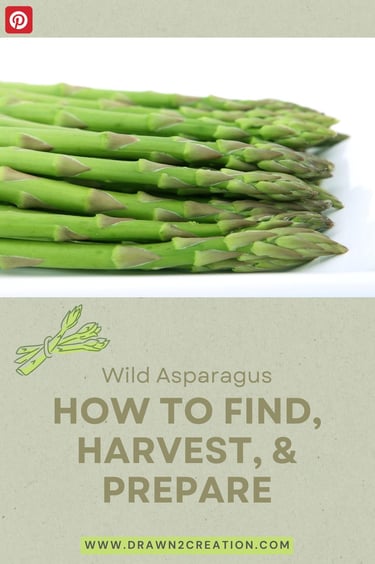Wild Asparagus: How to Find, Harvest, and Prepare
Discover how to find, identify, and harvest wild asparagus with practical tips, recipes, and reflections. Learn sustainable foraging and enjoy the bounty of God's creation.
RECIPESGARDEN & LAND
5/15/20258 min read


Foraging Wild Asparagus: How to Harvest & Prepare
There is something soothing and special about walking through the forest, field, or along country roads, with your eyes open to the treasures that God has tucked away. Foraging is a fun hobby...something to do or enjoy as you are out exploring the field or forest. But, it is really more than that. It's an invitation to slow down, to be present, and to delight in the blessings given by our Creator. It requires you to look around, to notice, and to appreciate the goodness that surrounds us everyday. It asks us to be grateful and appreciate the bounty that the land can provide. Plus, it's fun! It's like a treasure hunt and creative exercise all in one. You get to search for "treasures" as you explore, and then you get to make something creative and delicious with it after you find it!
This post will give practical tips about how to find, harvest, and prepare wild asparagus:
Note: I give product recommendations on this page. As an Amazon associate, I earn from qualifying purchases (at no additional cost to you).
Click to save for later!
Where to Find Wild Asparagus & How to Identify It
Wild asparagus is a perennial plant that will return year after year. It will often spread from year to year too, so once you find a good patch, you can return to it each year to gather some wild goodness! Asparagus likes to grow in sunny areas. You can often find it near old fences, in ditches, along country roads, or on the edges of farmland. Avoid any areas that may have been sprayed with chemicals like fertilizers, herbicides, or pesticides.
Spring is the best season to search. You can typically start to spot it growing in late April, and you can often harvest it through late May. Of course, it depends on where you live, but that is the typical time frame here in Wisconsin.
Wild asparagus can be tricky to identify at first. The young asparagus spears can easily blend into the surrounding greenery. You have to look carefully to spot the slender, green spears that are harvested. It is a bit easier to spot the tall feathery mature plants that grow from unharvested spears. They can grow up to 6 feet tall, and their leaves have a feathery appearance, like you would see on a dill plant or a fern. Once you spot the tall, mature asparagus plant, approach it and look closer. You will likely spot the slender stalks also growing nearby.
A few things to note:
It is a good idea to not harvest all of the asparagus stalks in an area. You want some to develop into mature plants. This allows the asparagus plant to produce seeds, and it means more asparagus the following year.
If you spot bright red berries on the mature female asparagus plants, do not harvest them. They are toxic.
Be aware of potential look-alikes. False indigo shoots can resemble black asparagus shoots, but the indigo plant will develop into a larger shrub. Some ferns produce similar leaves, but they will not produce the asparagus spear. ⭐Always be sure of what you are harvesting before you harvest it. If in doubt, leave it be.
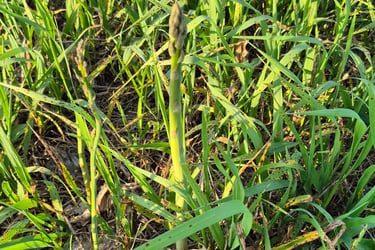

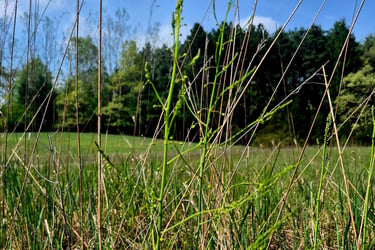

Mature plants turn brown in the fall and remain through winter. Scout for these plants in the off-season. You can make note of the areas in which you found them, and then return the following spring for a harvest of new spears!
How to Harvest, Store, & Preserve Wild Asparagus
When you find the young spears growing, look for those that are 6-10 inches tall. You can usually harvest them by simply snapping them off just above ground level, but they can also be harvested using a small knife. Be mindful as you harvest. It is usually a good idea to leave the thinner spears alone, so they can mature and go to seed. Avoid overharvesting. You want to have a perennial asparagus patch to return to year after year. Also be mindful of private property. Be sure to ask the landowner if you are on the edge of someone's land, even if you spot a roadside patch.
Fresh wild asparagus keeps best when it is kept moist and cool. I like to stand the cut spears upright in a cup or jar with some water in the bottom. If I am planning to cook up the asparagus that day, I will often just leave the spears in the cup or jar, like a bouquet of flowers. If I don't plan to use them for a few days, I will store the cut spears (in the cup or jar) in the refrigerator. Some will even loosely cover the top of the spears with a plastic bag. Alternatively, I also know of people who moisten paper towel and then wrap it around the base of the spears. They then place the bundle in a vegetable crisper until ready to use. Do what works best for you...the big idea is to keep them moist and cool until ready to use.
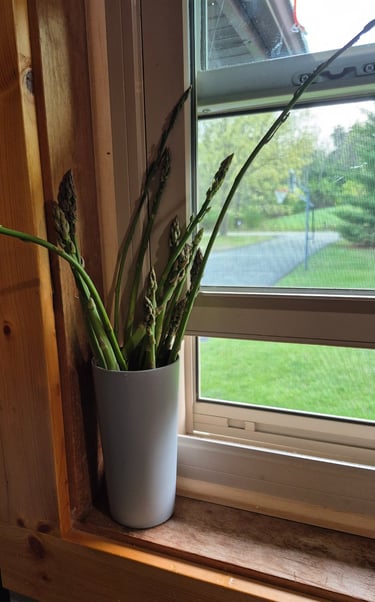

If you will need to store the harvested spears longer than 2-3 days, then it is best to prepare them for freezer storage. This can be done by blanching the spears for 2-3 minutes in boiling water. Then, immediately place them in ice water to stop the cooking process. After they are cooled, dry them and then freeze them in airtight bags.
Simple & Nutritious Wild Asparagus Recipes
Wild asparagus is tender and flavorful. It can really shine in a few simple dishes! Plus, asparagus is good for you! It is rich in vitamins A, C, E, and K. It is also a good source of folate and fiber. Asparagus supports detoxification, helps with digestion, and has anti-inflammatory properties.
Simple Sauteed Wild Asparagus with Garlic and Lemon:
Ingredients:
1 bunch of wild asparagus
2 cloves of garlic, minced
2 tablespoons of olive oil
1/2 teaspoon of sea salt
Juice of half a lemon
Instructions:
Cut the asparagus spears into pieces that will fit into a skillet.
Heat the olive oil in a skillet over medium heat.
Add the garlic. Cook for approximately 1 minute, until fragrant.
Add the asparagus spears. Sauté for 5-7 minutes. You want them to be tender-crisp.
Season with sea salt.
Squeeze lemon juice over the plated spears.
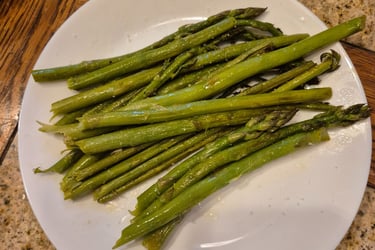

Wild Asparagus and Herb Quiche
Ingredients:
1 pre-baked pie crust
1 cup chopped wild asparagus
1/2 cup of chopped onions
2 tablespoons of olive oil
4 eggs
1 cup of milk (non-dairy alternatives can work too)
1/2 cup of shredded cheese (your choice)
2 tablespoons of chopped fresh herbs (your choice - chives, parsley, thyme all work well)
1/2 teaspoon of salt
1/4 teaspoon of black pepper
Instructions:
Preheat the oven to 375 degrees Fahrenheit.
Heat the olive oil in a skillet over medium heat.
Add the chopped asparagus and onions. Sauté for 3-4 minutes.
In a mixing bowl, whisk the eggs, milk, salt, pepper, herbs, and cheese.
Stir in the asparagus.
Pour the mixture into the crust. Bake for 35-40 minutes, or until the center is set.
Let cool before slicing.
Vegetable Stir Fry with Wild Asparagus
Ingredients:
1 bunch of wild asparagus, cut into 2 inch pieces
1 cup of sugar snap peas
1 cup of sliced bell pepper
1/2 cup of sliced onions
1 tablespoon of sesame oil
2 tablespoons of coconut aminos or soy sauce
1 garlic clove, minced
white or brown rice, cooked (as much as you would like)
Instructions:
Heat the sesame oil in a wok or skillet.
Add the minced ginger and cook for approximately 1 minute, until fragrant.
Add all of the veggies and stir fry for 5-6 minutes, or until tender-crisp.
Splash with soy sauce or coconut aminos and stir well.
Serve over rice.
Creamy Wild Asparagus Soup
Ingredients:
3 cups of chopped wild asparagus
1 tablespoon of olive oil
1 small onion, chopped
2 cloves of garlic, minced
3 cups of vegetable broth
1/2 cup of coconut milk or heavy cream
salt and pepper (to taste)
Instructions:
In a pot, heat the oil.
Sauté the chopped onion until soft and translucent.
Add the minced garlic and asparagus and cook for 3-4 minutes.
Pour in the vegetable broth. Simmer for 15 minutes.
Use an immersion blender to blend until smooth.
Stir in the coconut milk or heavy cream.
Season to taste.


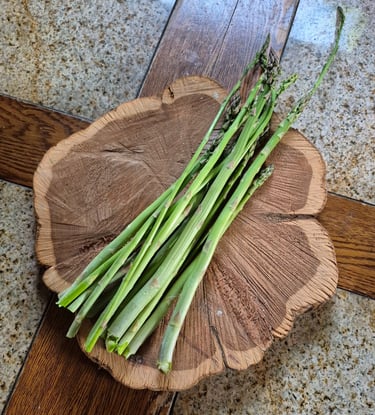





To wrap things up...
Foraging is a way to recognize God's fingerprint in every blessing from the land. As you walk the fields and forest, may your eyes be open not only to the wild asparagus plants, but also to the countless ways in which God provides. Remember to slow down, notice the goodness of creation all around you, and thank God for his constant provision.
If you enjoyed this post, please consider sharing! The sharing options are on the edge of the screen. Thank you for supporting our content!
Click to save for later!
⭐You may also enjoy these posts:
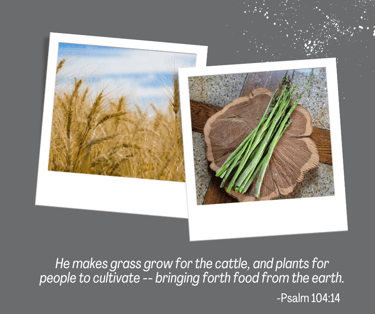

🛍️If you are interested in foraging, these products may be of interest:
References
“Asparagus: This is also a plant that can be easily spotted.” Wisconsin Natural Resources Magazine, Wisconsin Department of Natural Resources, Spring 2021, https://dnr.wisconsin.gov/wnrmag/2021/Spring/Forage.
Green Deane. “Wild Asparagus.” Eat The Weeds, 2010, http://www.eattheweeds.com/wild-asparagus/.
“False Indigo.” The Morton Arboretum, https://mortonarb.org/plant-and-protect/trees-and-plants/false-indigo/.
Peterson, Lee Allen. A Field Guide to Edible Wild Plants: Eastern and Central North America. Houghton Mifflin Harcourt, 1977.
Thayer, Samuel. The Forager’s Harvest: A Guide to Identifying, Harvesting, and Preparing Edible Wild Plants. Forager’s Harvest Press, 2006.
“Wild Asparagus Nutrition Facts.” NutritionValue.org, 2024, https://www.nutritionvalue.org/Asparagus%2C_raw_nutritional_value.html.
“Winter Woodland Wonders.” Plant Talk Blog, New York Botanical Garden, 12 Dec. 2012, https://www.nybg.org/blogs/plant-talk/2012/12/tip-of-the-week/winter-woodland-wonders/.
“Ethical Wildcrafting Guidelines.” United Plant Savers, https://unitedplantsavers.org/ethics-of-wildcrafting/.
“Asparagus officinalis.” USDA Plants Database, United States Department of Agriculture, https://plants.usda.gov/home/plantProfile?symbol=ASOF.
Be sure to check out our shop!
We have digital products related to outdoor family fun, family travel, Christmas, and more!
Join our community for updates, recommendations, and offers.
We'll give you access to our downloadable files as a thank you!
Adventure Planner
Daily Journal Template
Camping Adventure Planning Packet
We will send regular emails (typically monthly) with outdoor, faith, and family info you can use. You can unsubscribe from those emails at any time.
Connect
info@drawn2creation.com
Follow us!
Copyright Drawn2Creation

